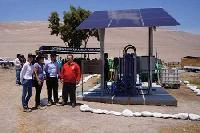










Solar Desalination Plant
Solar desalination is a technique to remove salts from water – usually seawater – using solar energy to make the water potable. Desalination has become important in supplying the world’s drinking water; In the middle of the 20th century, there were about 4,000 cubic meters of fresh water per person per year. Now, globally, we’re down to 1,000 cubic meters per person per year — a level that is defined as water scarcity. Some communities were using solar stills for desalination back in the 1950s, mostly in remote desert and coastal areas, but they didn’t really take off because of cheap pumps and pipelines and low energy costs. There are two major types of solar desalination systems: reverse osmosis and solar humidificationdehumidification. Reverse osmosis is a pressure-driven process that forces the separation of fresh water from other constituents through a semipermeable membrane; it is the method most used in large-scale desalination systems where electricity is readily available. The solar humidification-dehumidification (HDH) process, or multiple-effect humidification (MEH), is a technique that mimics the natural water cycle in a shorter time frame by evaporating and condensing water to separate it from other substances. The driving force in this process is thermal solar energy to produce water vapor that is later condensed in a separate chamber. Some HDH systems, collect the waste heat from the condensing water vapor and pre-heat the incoming water source; it’s often effective for small- to mid- scale desalination systems in remote locations because of the relatively low cost of solar collectors.